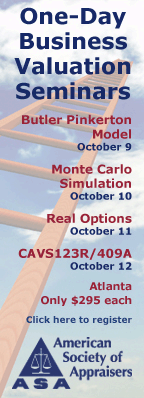
| Would any of the current DLOM models pass Daubert? “We have a broken system,” the Honorable David Laro (U.S. Tax Court) told over one hundred attendees at the first-ever Summit on Discount for Lack of Marketability (DLOM) in San Diego last week. “The law is more complicated than ever." Over 240 sections of the Internal Revenue Code pertain to fair market valuations in the estate and gift tax arena as well as conservation easements and the trillion dollar market for derivatives. Multiple credentialing organizations provide continuous education and improvements to the business valuation profession, while on the other side, the government now recognizes that its agents and appraisers must meet certain minimum practice standards. But when the IRS issues a notice of deficiency, the taxpayer disputes the adjustment—and each side ends up in court with an expert espousing widely divergent opinions on value—that’s when “things aren’t working,” Laro said. “Courts say we don’t want you to be hired guns or advocates,” he added, “but we have missed the opportunity to challenge the admissibility of your opinions at the gate-keeping juncture.” Although the latest studies by the federal judiciary and PricewaterhouseCoopers show that over 50% of all Daubert challenges are directed at financial experts (see BVWire™ #64-2)—very few appear in Tax Court on valuation methodologies—specifically those concerning one of the most controversial calculations: the DLOM. Challenge to appraisers. “Why aren’t [attorneys] questioning valuation methods at the Daubert level more often?” Judge Laro said, a rhetorical question that nevertheless got the attention of appraisers at the DLOM Summit. “We are admitting valuation testimony that is not helpful or reliable.” More frequent challenges would motivate experts to move to higher methodologies and might even force a unified, consistent, generally accepted model for determining DLOM. In the meantime, courts will continue to pick from dueling appraisals or appoint “neutral” experts to provide independent opinions—a trail that Laro blazed in Bank One v. Commissioner (2003) (abstract and court opinion available at BVLibrary.com). And while the Summit brought together the top leaders in the field today—including presentations by Chris Mercer, Ashok Abbott, Lance Hall, and hardball questions from Jim Hitchner—the conflicts among DLOM theories are far from reconciled. “This is a situation in need of improvement,” Laro said, in his closing remarks. If you were unable to attend the Summit, be sure to catch BVResources’ next teleconference, “Discounts for Lack of Marketability” hosted by Brian Pearson (Valuation Advisors) on Thursday, October 2, 2008. Pearson will recap the Summit, the pros and cons of the various approaches, and provide an open Q&A period on how to calculate the DLOM, including views from the experts as well as Judge Laro. Click here to register for the teleconference. For more information on the subject of DLOM, readers may be interested in the recently updated BVR’s Guide to the Discounts for Lack of Marketability, which includes new articles and hundreds of the most important and recent court cases on DLOM. For more information, click here. ‘Official’ IRS position on DLOM Among the most anticipated speakers at the DLOM Summit was Howard Lewis, who just retired as National Program Manager for the IRS’s Engineering and Valuation programs to lead the Institute of Business Appraisers as its new Executive Director (see BVWire #70-5). Lewis began his remarks in a light-hearted manner by recalling a professional conference on the discount rate, where the speaker stood up and said, “Good morning, the discount rate is 18%,” and then sat down. As for what the IRS’s “official position” on marketability discounts may be—“I don’t have a clue," Lewis quipped. “There is no such thing as an official position. There are hundreds of valuators, managers, appraisers, and service agents—all of whom are trying to solve this problem, and all are frustrated by the process and its problems.” Lewis likened the situation to a taxi trip from New York’s LaGuardia Airport to nearby Forest Hills, which should take ten minutes but ends up, after multiple detours and distractions, taking two hours. “That’s what’s happening in valuation analysis today,” Lewis said. “We’re trying to get to the right answer but we’ve created a process that’s fraught with risk and waste.” Analysis must be market-based. Regardless of which model or methodology you use, Lewis told Summit attendees, “make sure your analysis begins and ends with the market.” After all, the root of the calculation is the marketability discount within the overarching determination of fair market value. “We need to shorten the trip and simplify the process and focus on the market,” Lewis said, “because that’s where the answer lies.” For a complete summary of his remarks, plus exclusive interviews with Summit moderators and organizers, see the November Business Valuation Update™. Jelke briefs are in: Now it’s up to U.S. Supreme Court In a decision that could have a “profound effect on valuation,” according to attorney John Prokey (Ramsbacher Prokey, LLP), the U.S. Supreme Court has now received the IRS’s petition for writ of certiorari in Commissioner v. Estate of Jelke, the 11th Circuit’s approval of a dollar-for-dollar discount for embedded capital gains (see BVWire # 62-3 and #64-3). The taxpayer filed its response in August, followed by the IRS’s reply on September 3, 2008. Briefs from “friends of the court” will surely be forthcoming if the Supreme Court grants cert in the case. The key issue: whether the choice of methodology for valuing the embedded capital gains tax of a closely held corporation is a matter of fact or law. If it’s the former, as the IRS contends, then the trial court is given broad discretion to make its valuation determinations based on the facts and circumstances of each case, reversible on appeal only for “clear error.” But if the application of a particular valuation methodology (net asset value, in this case) is a question of law, as the taxpayer argues, then an appellate court reviews the method de novo (as new), which is what the 11th Circuit did in its rejection of the Tax Court’s original findings in Jelke. Only the determinations of value would then be factual and within the trial court’s discretion. The Supreme Court could rule on the basis of the briefs alone, Prokey told attendees at the DLOM Summit in San Diego—or it could set the case for oral argument; or it could decline the case altogether. The timing of the decision is also unclear—but tax attorneys and appraisers alike will be awaiting the outcome, wondering whether the certainty of a dollar-for-dollar discount trumps the alleged accuracy of valuation methodologies. Click here to read all three briefs in the Jelke appeal to the highest court. Industry leaders pledge support for TAF’s draft Strategic Plan In a two-page letter penned to The Appraisal Foundation (TAF), the American Society of Appraisers, the American Society of Farm Managers and Rural Appraisers and the National Association of Independent Fee Appraisers expressed “strong support” for TAF’s Strategic Plan and “the overall direction it charts for what TAF intends to accomplish over the next several years.” Why the ringing endorsement? Among other things, the trio notes that TAF’s Plan and vision of its future role address several key issues affecting valuation practice and the appraisal profession. Some of the Plan highlights more specific to the business valuation community include:
If you’d like to read the letter, we’ve posted it here. Damodaran on Equity Risk PremiumsProfessor Aswath Damodaran (Stern School of Business, New York) has recently posted a new 74-page article titled Equity Risk Premiums (ERP): Determinants, Estimation and Implications (the article appears as item number one under Research/Papers on his website). In it, he investigates:
He also considers two questions: “why the numbers vary across approaches and…how to choose the ‘right’ number to use in analysis.” Readers may also be interested to see A Survey Paper on Valuation listed as item four under Research/Papers—and that he’s working on the second edition of The Dark Side of Valuation due out at the end of the year. Buying a business at asset valueThe September 10, 2008, BVWire article titled How low can you go? cited an original article by River’s Edge Alliance Group, LLC, located here. The article raised the question—what is the floor value for a cash negative business?—and included “the fixed assets of a breakeven or cash negative business do not dictate a ‘basement’ price that a buyer should be willing to pay for the business….the buyer should discount the assets.” Noreen Dornenburg, ASA, PhD (Urish Popeck & Co., LLC, Pittsburgh) replied to the BVWire as follows:
Free guide to valuing mining companies Ian Campbell, BBA, FCA, FCBV (Campbell Valuation Partners, Canada), has published the first of his 17 post series on the valuation of mining companies. The posts stem from his recently updated E-book which is sub-divided into 17 blog posts. The initial posts contain an introduction and an index of what’s to come. Subsequent posts will include an overview of the industry, risk assessment, and valuation methods that include asset based, earnings and cash flow based, comparables based and other valuation methodologies. Campbell is a Fellow of the Institute of Chartered Accountants of Canada and a founding member and Fellow of the Canadian Institute of Chartered Business Valuators. View the first post in this series here. FASB complete; IASB still underway In the Ready, set, converge article in last week's issue of BVWire (issue #72-2), we inadvertently stated that the fair value measurement project had been completed. Hilary Eastman, the fair value measurement project manager at the IASB, reported to the BVWire that the fair value measurement project is completed by the FASB and is currently underway at the IASB. As of now, the IASB still estimates a completion date in 2010. |
To ensure this email is delivered to your inbox,
please add editor@bvwire.com to your e-mail address book.
We respect your online time and privacy and pledge not to abuse this medium. To unsubscribe to BVWire™ reply to this e-mail with 'REMOVE BVWire' in the subject line or click here.
Copyright © 2008 by Business Valuation Resources, LLC
BVWire™ (ISSN 1933-9364) is published weekly by Business Valuation Resources, LLC
Editorial Staff | Advertise in the BVWire | Copyright Notice
|
|


